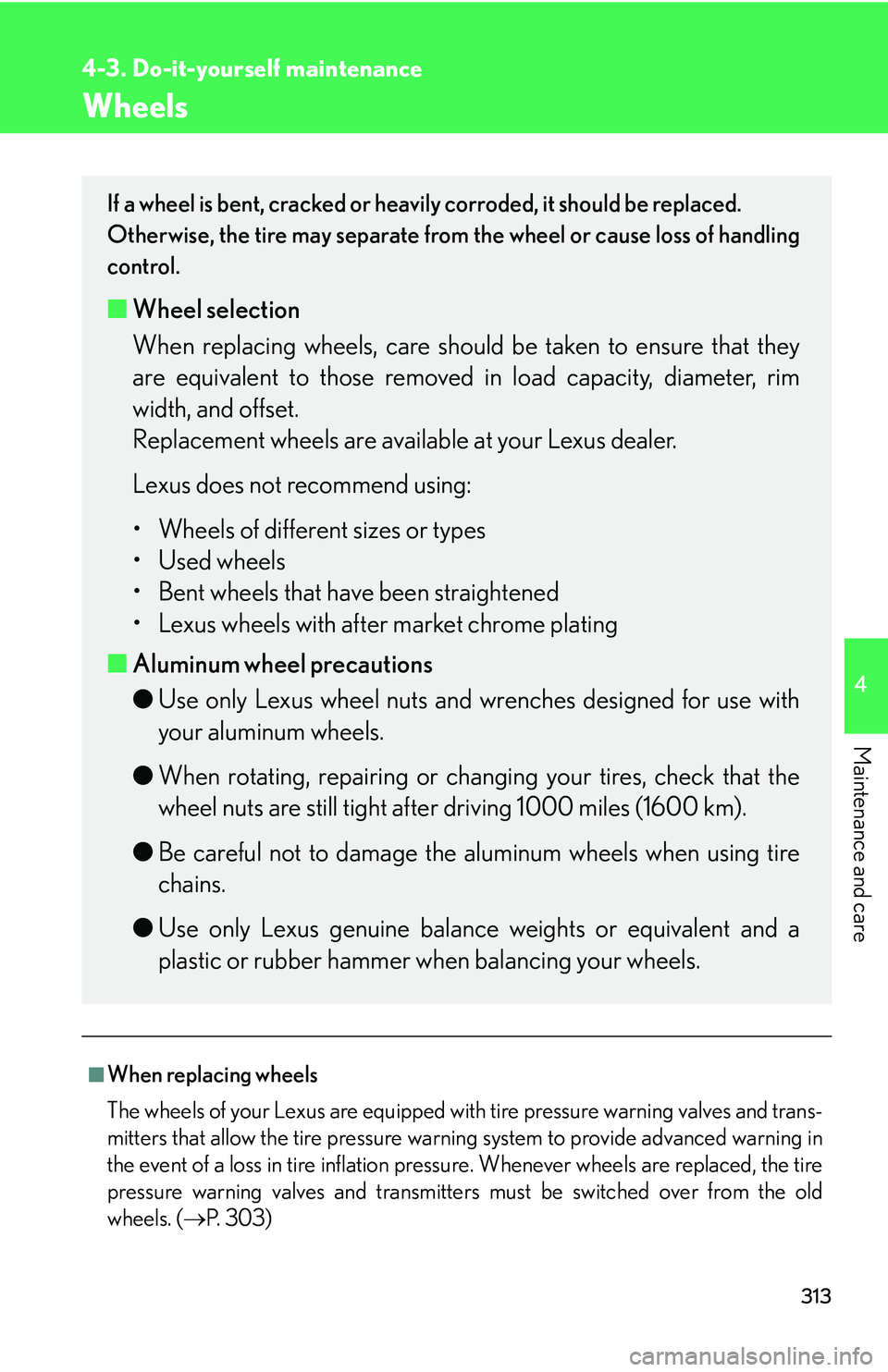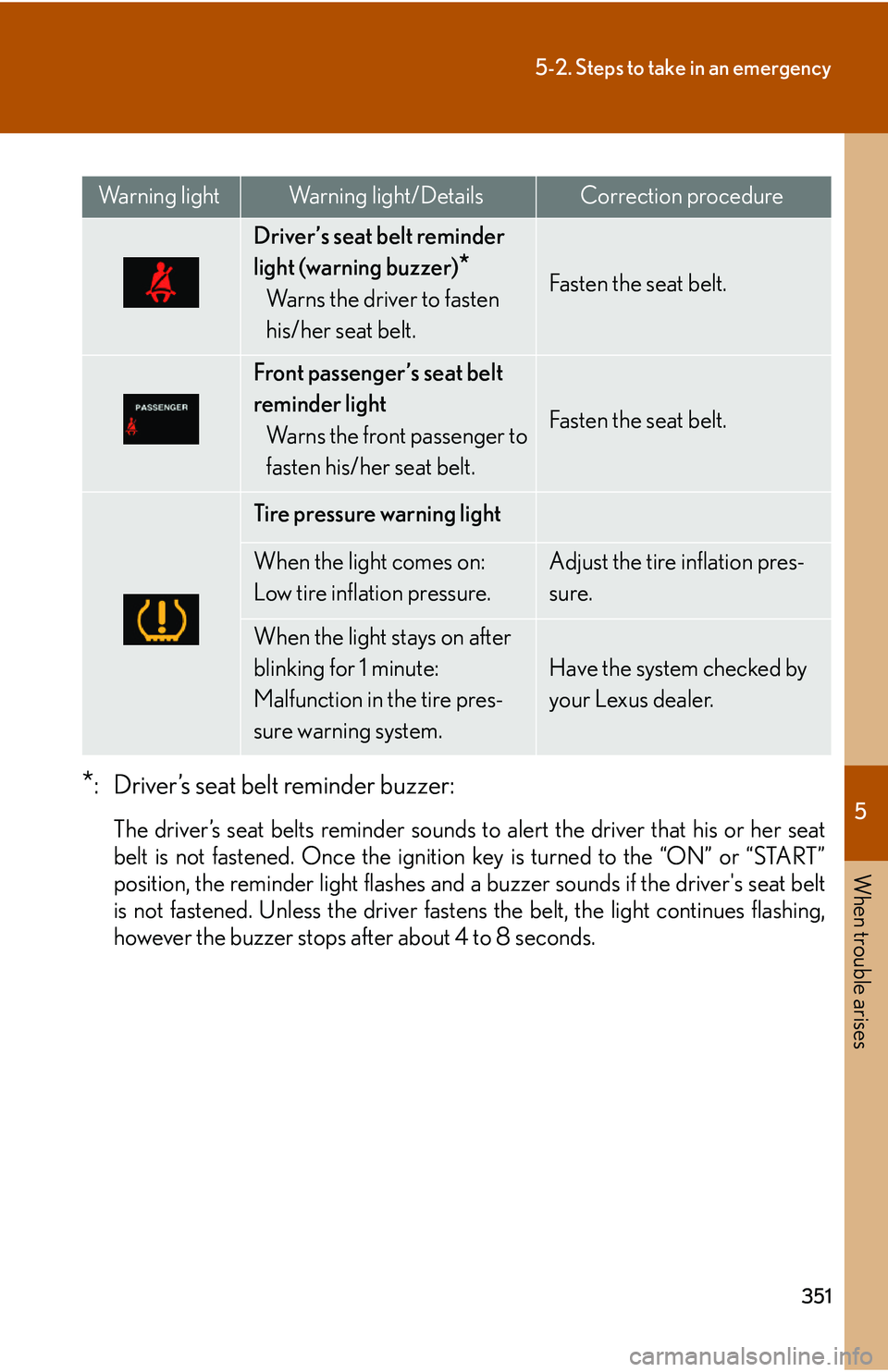inflation pressure Lexus GX470 2007 Using other driving systems /
[x] Cancel search | Manufacturer: LEXUS, Model Year: 2007, Model line: GX470, Model: Lexus GX470 2007Pages: 436, PDF Size: 11.52 MB
Page 329 of 436

309
4-3. Do-it-yourself maintenance
4
Maintenance and care
Tire inflation pressure
■Tire inflation pressure
The recommended cold tire inflation pressure and tire size is dis-
played on the tire and loading information label. ( P. 385)
Page 330 of 436

310
4-3. Do-it-yourself maintenance
.
■Tire inflation pressure check interval
You should check tire inflation pressure every 2 weeks, or at least once a month.
Do not forget to check the spare.
■Inspection and adjustment procedure
Ti r e v a l v e
Tire pressure gauge
Remove the tire valve cap.
Press the tip of the tire pressure gauge onto the tire valve.
Read the pressure using the graduations of the gauge.
If the tire inflation pressure is not within the recommended lev-
els, adjust tire pressure.
If you add too much air, press the center of the valve to lower.
After completing the tire inflation pressure measurement and
adjustment, apply soapy water to the valve and check for leak-
age.
Reinstall the tire valve cap.
STEP1
STEP2
STEP3
STEP4
STEP5
STEP6
Page 331 of 436

311
4-3. Do-it-yourself maintenance
4
Maintenance and care
■Effects of incorrect tire inflation pressure
Driving with incorrect tire inflation pressure may result in the following:
●Reduced fuel efficiency
●Reduced driving comfort and tire life
●Reduced safety
●Damage to the drive train
If a tire needs frequent refilling, have it checked by your Lexus dealer.
■Instructions for checking tire inflation pressure
When checking tire inflation pressure, observe the following:
●Check only when the tires are cold.
If your vehicle has been parked for at least 3 hours and has not been driven for
more than 1 mile or 1.5 km, you will get an accurate cold tire inflation pressure
reading.
●Always use a tire pressure gauge.
The appearance of the tire can be misleadi ng. In addition, tire inflation pressures
that are even just a few pounds off can degrade ride and handling.
●Do not bleed or reduce tire inflation pressure after driving. It is normal for the
tire inflation pressure to be higher after driving.
●Never exceed the vehicle capacity weight.
Passengers and luggage weight should be placed so that the vehicle is bal-
anced.
Page 332 of 436

312
4-3. Do-it-yourself maintenance
CAUTION
■Proper inflation is critical to save tire performance
Keep your tires properly inflated. Otherwise, the following conditions may occur
and result in an accident causing death or serious injury.
●Excessive wear
●Uneven wear
●Poor handling
●Possibility of blowouts resulting from overheated tires
●Poor sealing of the tire bead
●Wheel deformation and/or tire separation
●A greater possibility of tire damage from road hazards
NOTICE
■When inspecting and adjusting tire inflation pressure
Be sure to reinstall the tire valve caps.
Without the valve caps, dirt or moisture could get into the valve and cause air leak-
age, which could result in an accident. If the caps have been lost, replace them as
soon as possible.
Page 333 of 436

313
4-3. Do-it-yourself maintenance
4
Maintenance and care
Wheels
■When replacing wheels
The wheels of your Lexus are equipped with tire pressure warning valves and trans-
mitters that allow the tire pressure warning system to provide advanced warning in
the event of a loss in tire inflation pressure. Whenever wheels are replaced, the tire
pressure warning valves and transmitters must be switched over from the old
wheels. ( P. 3 0 3 )
If a wheel is bent, cracked or heavily corroded, it should be replaced.
Otherwise, the tire may separate from the wheel or cause loss of handling
control.
■ Wheel selection
When replacing wheels, care should be taken to ensure that they
are equivalent to those removed in load capacity, diameter, rim
width, and offset.
Replacement wheels are available at your Lexus dealer.
Lexus does not recommend using:
• Wheels of different sizes or types
• Used wheels
• Bent wheels that have been straightened
• Lexus wheels with after market chrome plating
■ Aluminum wheel precautions
●Use only Lexus wheel nuts and wrenches designed for use with
your aluminum wheels.
● When rotating, repairing or changi ng your tires, check that the
wheel nuts are still tight after driving 1000 miles (1600 km).
● Be careful not to damage the aluminum wheels when using tire
chains.
● Use only Lexus genuine balance weights or equivalent and a
plastic or rubber hammer when balancing your wheels.
Page 371 of 436

5
When trouble arises
351
5-2. Steps to take in an emergency
*: Driver’s seat belt reminder buzzer:
The driver’s seat belts reminder sounds to alert the driver that his or her seat
belt is not fastened. Once the ignition key is turned to the “ON” or “START”
position, the reminder light flashes and a buzzer sounds if the driver's seat belt
is not fastened. Unless the driver fasten s the belt, the light continues flashing,
however the buzzer stops after about 4 to 8 seconds.
Warning lightWarning light/DetailsCorrection procedure
Driver’s seat belt reminder
light (warning buzzer)
*
Warns the driver to fasten
his/her seat belt.Fasten the seat belt.
Front passenger’s seat belt
reminder light
Warns the front passenger to
fasten his/her seat belt.
Fasten the seat belt.
Tire pressure warning light
When the light comes on:
Low tire inflation pressure.Adjust the tire inflation pres-
sure.
When the light stays on after
blinking for 1 minute:
Malfunction in the tire pres-
sure warning system.
Have the system checked by
your Lexus dealer.
Page 373 of 436

5
When trouble arises
353
5-2. Steps to take in an emergency
■When the tire pressure warning light comes on
Check the tire inflation pressure and adjust to the appropriate level.
■The tire pressure warning light may turn on due to natural causes
The tire pressure warning light may turn on due to natural causes such as natural air
leaks or tire inflation pressure changes caused by temperature. In this case, adjust-
ing the tire inflation pressure will turn off the warning light.
■When a tire is replaced with a spare tire
The spare tire is also equipped with the tire pressure warning valve and transmitter.
The tire pressure warning light will turn on if the tire inflation pressure of the spare
tire is low. If a tire goes flat, even though the flat tire is replaced with the spare tire,
the warning light does not turn off. Replace the spare tire with the repaired tire and
adjust the proper tire inflation pressure. The warning light will turn off after a few
minutes.
■If the tire pressure warning system is inoperative
The tire pressure warning system may become inoperative in the following condi-
tions:
(When the condition becomes normal, the system will work properly.)
●If tires not equipped with tire pressure warning valves and transmitters are used.
●If the ID code on the tire pressure warning valves and transmitters is not regis-
tered.
●If electronic devices or facilities using similar radio wave frequencies are nearby.
●If a radio set at similar frequencies is in use in the vehicle.
●If a window tint that affects the radio wave signals is installed.
●If the tire pressure warning select switch is set to a different tire setting.
●If there is a lot of snow or ice on the vehicle, in particular around the wheels or
wheel housings.
●If non-genuine Lexus wheels are used.
●If tire chains are used.
●If the tire inflation pressure is 73 psi (500 kPa, 5.1 kgf/cm2 or bar) or higher.
●If the tire is in a location subject to poor radio wave signal reception.
Page 374 of 436

354
5-2. Steps to take in an emergency
■If the tire pressure warning light comes on after blinking for 1 minute frequently
If the tire pressure warning light comes on after blinking for 1 minute frequently
when the ignition switch is turned to th e “ON” position, have it checked by your
Lexus dealer.
■After changing the engine oil (U.S.A. only)
Make sure to reset the oil maintenance data. ( P. 2 9 2 )
CAUTION
■Maintenance of the tires
Each tire, including the spare (if provided ), should be checked monthly when cold
and inflated to the inflation pressure re commended by the vehicle manufacturer on
the vehicle placard or tire inflation pressu re label (tire and load information label).
(If your vehicle has tires of a different size than the size indicated on the vehicle
placard or tire inflation pressure label [tire and load information label], you should
determine the proper tire inflation pressure for those tires.)
As an added safety feature, your vehicl e has been equipped with a tire pressure
monitoring system (TPMS-tire pressure warning system) that illuminates a low tire
pressure telltale (tire pressure warning light) when one or more of your tires is sig-
nificantly under-inflated. Accordingly, when the low tire pressure telltale (tire pres-
sure warning light) illuminates, you should stop and check your tires as soon as
possible, and inflate them to the proper pressure. Driving on a significantly under-
inflated tire causes the tire to overheat and can lead to tire failure. Under-inflation
also reduces fuel efficiency and tire tread life, and may affect the vehicle's handling
and stopping ability.
Please note that the TPMS (tire pressure warning system) is not a substitute for
proper tire maintenance, and it is the driv er's responsibility to maintain correct tire
pressure, even if under-inflation has not reached the level to trigger illumination of
the TPMS low tire pressure telltale (tire pressure warning light).
Page 375 of 436

5
When trouble arises
355
5-2. Steps to take in an emergency
CAUTION
■If the tire pressure warning light comes on
Be sure to observe the following precautions. Failure to do so could cause loss of
vehicle control and result in death or serious injury.
●Stop your vehicle in a safe place as soon as possible. Adjust the tire inflation pres-
sure immediately.
●If the tire pressure warning light comes on even after tire inflation pressure adjust-
ment, it is probable that you have a flat tire. Check the tires. If the tire is flat,
change to the spare tire and have the flat tire repaired by the nearest Lexus
dealer.
●Avoid abrupt maneuvering and braking. If the vehicle tires deteriorate, you could
lose control of the steering wheel or the brakes.
■If a blowout or sudden air leakage should occur
The tire pressure warning system may not activate immediately.
NOTICE
■Precaution when installing a different tire
When a tire of a different specification or maker is installed, the tire pressure warn-
ing system may not operate properly.
Page 405 of 436

385
6-1. Specifications
6
Vehicle specifications
Chassis lubrication
Steering
Tires and wheels
Propeller shafts
Spiders
Slide yokeLithium base chassis grease, NLGI No.2
Molybdenum-disulfide lithium base chassis
grease,
NLGI No.2 or lithium base chassis grease,
NLGI No.2
Free playLess than 1.2 in. (30 mm)
Power steering fluidAutomatic transmission fluid DEXRON® II
or III
Ti r e s i z eP265/65R17 110S
Tire inflation pressure
(Recommended cold tire inflation
pressure)
Driving under normal conditions 32 psi (220 kPa, 2.2
kgf/cm2 or bar)
Driving at high speeds above 100 mph (160
km/h) (in countries where such speeds are per-
mitted by law) Add 9 psi (60 kPa, 0.6 kgf/cm
2 or bar) to the
front tires and rear tires. Never exceed the
maximum cold tire inflation pressure indicated
on the tire sidewall.
Wheel size17 7 1 /2 JJ
Wheel nut torque83 ft•lbf (112 N•m, 11.5 kgf•m)